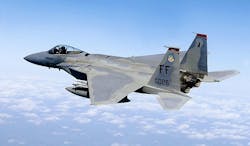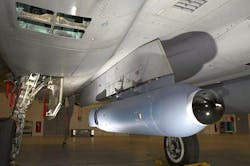Boeing and Lockheed Martin to build stealthy infrared search and track (IRST) avionics for F-15C jet fighter
WRIGHT-PATTERSON AFB, Ohio – U.S. Air Force air combat experts are asking electro-optics engineers at the Boeing Co. and Lockheed Martin Corp. to design and build six additional infrared search and track (IRST) sensors for the F-15C Eagle jet fighter to enable the aircraft to detect, track, and attack enemy aircraft in a stealthy way without making its presence known.
Officials of the Air Force Life Cycle Management Center at Wright-Patterson Air Force Base, Ohio, announced a potential $40 million order Monday to the Boeing Co. Defense, Space & Security segment in St. Louis to integrate six IRST Block II systems for The single-seat F-15C jet fighter.
The F-15C's IRST is a long-wave infrared detection system that targets aircraft in a radar-denied environment. The system, which Boeing is buying from the Lockheed Martin Missiles and Fire Control segment in Orlando, Fla., uses infrared search and track technology to detect and provide weapon-quality track solutions on potentially hostile aircraft.
For the F-15C, Lockheed Martin is providing the company's Legion Pod sensor system, which consists of a passive longwave infrared receiver, a processor, inertial measurement unit, and environmental control unit. The infrared receiver, processor, and inertial measurement unit fit inside the sensor pod, which attaches to a weapons station underneath the aircraft.
The Boeing F-15C jet fighter is a twin-engine all-weather tactical aircraft designed for air supremacy. The large jet fighter, designed in the 1970s, augments later-model Air Force F-22 jet fighters in the air interdiction and air superiority roles.
The F-15C's IRST Block II is based on the F-15K/SG aircraft's infrared receiver, which was inspired by the IRST design of the now-retired Navy F-14 Tomcat jet fighter. IRST Block II will include improvements to the infrared receiver and updated processors.
Even amid electronic attack or heavy RF and infrared countermeasures, IRST provides autonomous, tracking data that increases pilot reaction time, and enhances survivability by enabling first-look, first-shoot capability, Lockheed Martin officials say.
Infrared sensors like the IRST detect the heat from an aircraft's engine exhaust or even the heat generated by the friction of an aircraft as it passes through the atmosphere. Unlike radar, infrared sensors do not emit electronic signals, and do not give away their presence to adversaries.
Related: Opinion: a 1970s legacy jet fighter, the F-15 mission is complete
This ability can enable F-15C pilots to make positive identification of enemy aircraft at long ranges, and enable them to fire their air-to-air missiles at their maximum ranges.
Data from the IRST system can stand alone or fuse with other on-board sensor data situational awareness. Lockheed Martin also is building IRST systems for the Air Force F-16 jet fighter and for the Navy F/A-18E/F Super Hornet jet fighter-bomber.
On this contract Boeing and Lockheed Martin will do the work in Orlando, Fla., and in St. Louis, and should be finished by October 2022. For more information contact Boeing Defense, Space & Security online at www.boeing.com/company/about-bds, www.lockheedmartin.com, or Naval Air Systems Command at www.navair.navy.mil.
Ready to make a purchase? Search the Military & Aerospace Electronics Buyer's Guide for companies, new products, press releases, and videos


